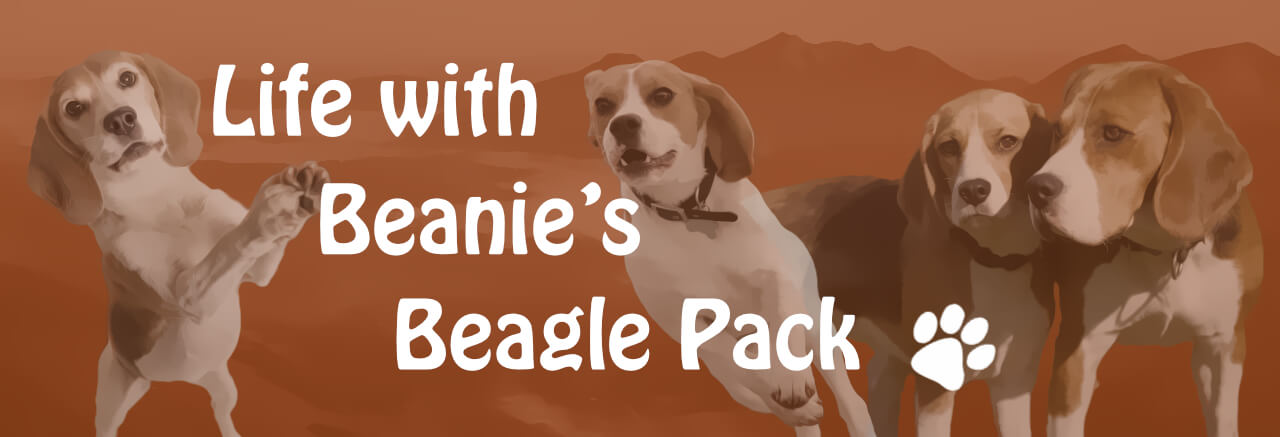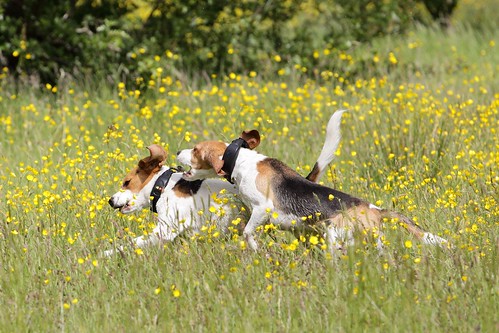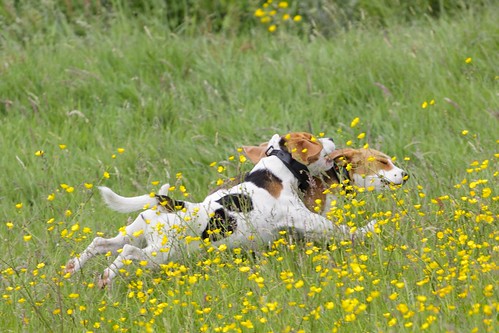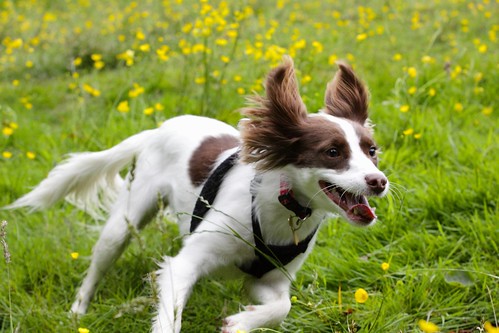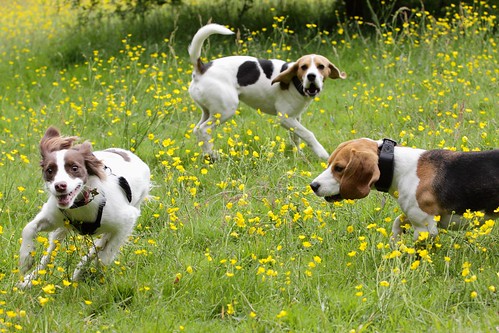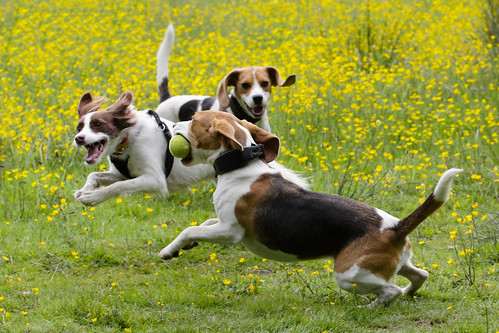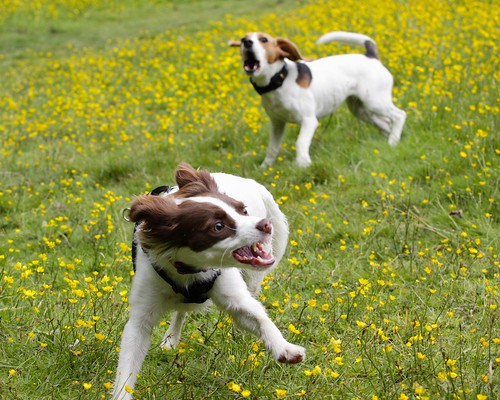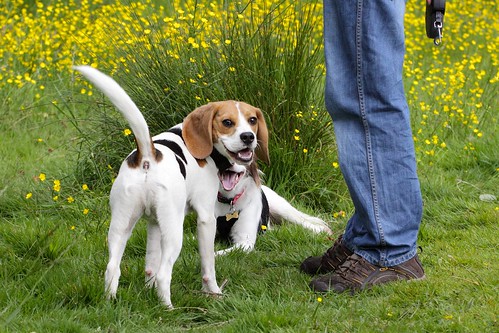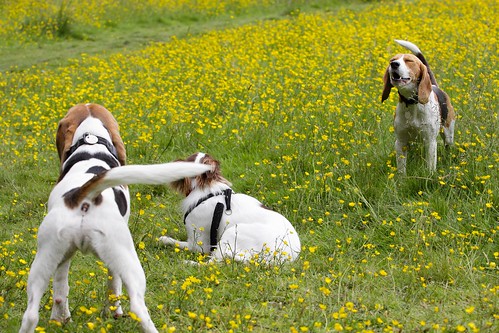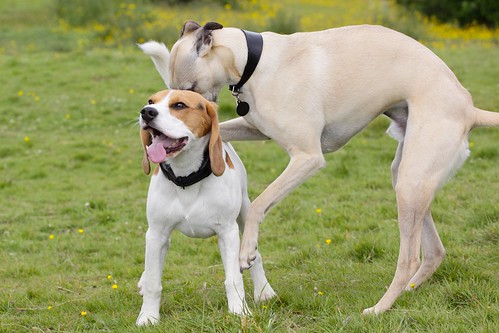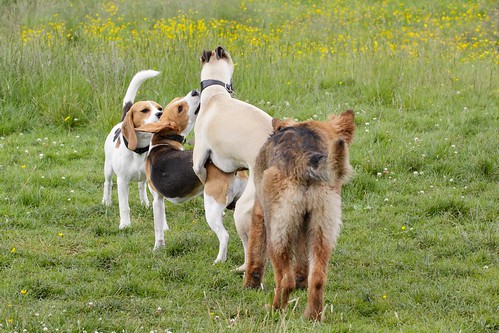For some time now we’ve been having trouble with Beanie and Biggles running off on their own adventures during our walks in our local park. We’ve tried various things to curb this behavior; we’ve walked them separately, worked really hard at making ourselves more exciting by playing high energy games, and carried all manner of succulent treats to get them to stay with us. While some of these measures helped to a degree, some days nothing would stop our two intrepid Beagles doing their disappearing act.
Finally we turned to a book that was recommended to us some time ago by Beanie’s agility instructor: When Pigs Fly by Jane Killion. It’s aimed specifically at “difficult” dogs like hounds and terriers. The early chapters of the book describe our two pups perfectly: energetic, resourceful & intelligent but completely uninterested in pleasing us. They’re not difficult to train in that they can learn things really quickly, but they only comply with our requests when it suits them. In short, they are not “biddable” dogs.
Like many owners of “independent thinking” dogs, we’ve fallen into the trap of trying to bribe them into cooperation by constantly using treats, and running around like crazy people to try to hold their attention. Most of the professional dog trainers we’ve met have warned us about this, but none of them have been able to offer an alternative that works. Trying to wean Beanie and Biggles off their treats just results in them losing interest in us even more quickly.
The Pigs Fly book claims to be able to turn this around and put your dog into a receptive, biddable state by tapping into his/her innate problem-solving ability (this is the very thing that makes hounds and terriers great for the things they were originally bred to do, but not so hot as cooperative dote-on-your-every-word pets). Clicker training is at the heart of the system, but with a strong emphasis on “free shaping”. We’ve used clicker training for Beanie & Biggles but always with prompting and the use of food as lures. In other words, we manipulated them into the behavior we wanted and just used the clicker to reinforce it.
Free shaping with the clicker takes an altogether different approach. In a free shaping session you don’t prompt or lure the dog, you just patiently wait for the dog to spontaneously perform an action or part of an action and click and treat to mark it as desirable. Over time you shape the behavior you’ve just captured by being more picky about what merits a click. As an example here’s a short clip of a boxer being trained to perform a bow via free shaping here:
http://www.youtube.com/watch?v=1iKaNN_XrnE
The clip is a bit misleading in that it gives the impression that free shaping is a quick process. In reality it’s usually a lot slower than traditional training methods, but according to the Pigs Fly book it’s especially effective for difficult dogs because it puts them into a biddable state – the dog ends up merrily throwing behaviors at you in the hope of discovering one that will get that elusive click.
My first free shaping session with Biggles was great fun, but also a little embarrassing. He ended up so eager to please he reminded me of that scene in Saving Private Ryan where the group take out a radar installation, and lose their medic in the process. They capture one of the German machine gunners alive and he’s so desperate to avoid being killed in revenge that he tries to win them over by cursing Hitler, praising Betty Grable’s legs and singing the Star-Spangled Banner (he doesn’t get a click and treat for all these laudable behaviors but Tom Hanks lets him live so I guess you could say the training session ended well). Biggles didn’t exactly sing the US national anthem but he did roll onto his back a lot which was much cuter.
Anyway, we carried this style of training over into our walks by clicking and treating any kind of behavior that involves our dogs paying attention to us. Once those behaviors were occuring frequently we randomly withheld clicks – according to the book this gives the training an addictive edge, like a gambler trying one more round in the hope of hitting the jackpot.
We’re now nearly a week into this new training regime and we are both finding that Beanie and Biggles are spending more time hanging around us and less time going off on their own adventures. It’s a great start, and I think it contributed to the great walk we had in the park this morning.
Beanie gives Biggles a mid-chase nibble..
..but he gives as good as he gets these days!
He even gets to lead some of the chases
The highlight of the walk was bumping into a little collie/spaniel cross called Millie. She was fit, full of energy and so fast that even Beanie had trouble keeping up with her at first. Biggles had an even harder time and became very vocal about it..
Every so often Millie got so excited she spun round and round on the spot leaving Biggles rather dazed..
Dad! Did you see that?
Eventually she needed a breather, but she didn’t realize that if you’re going to get our two super-excited, you’d better have the energy to keep going or you’re going to get an earful!
And lo, the chasing stopped and there was much woofing
Of course no walk in the park would be complete without a dog trying to hump Biggles, and he doesn’t like it. He’ll happily lie on he ground with his legs akimbo to get his naughty bits thoroughly sniffed and licked, but there’d better not be any rumpy-pumpy. He’s just not that sort of boy!
Seconds later the would-be humper received a stern telling off
Beanie on the other hand is very free with her affections, in fact she had ’em lining up!
So we’re going to keep going with the Pigs Fly system. It certainly seems to be working so far, though I’m not sure if I buy into the theories the author gives for its success – there are other possible (partial) explanations:
- You’re only rarely giving the dog commands. It’s up to the dog to deliver something that’s worthy of a click on his own initiative
- You’re genuinely rewarding only desirable behavior rather than inadvertently rewarding naughtiness by using food as a lure
- Maybe our dogs find our usual vocal outpourings a distraction whereas the clicker is ruthlessly succinct and consistent
- Maybe they sense the change in our attitude when doing free shaping – after all there’s no failure in this kind of training, just different degrees of success
